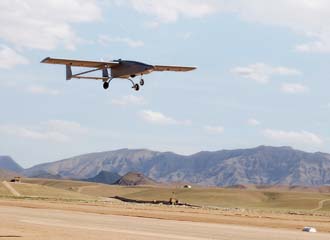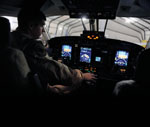NATO Works MAJIIC Again
 |
A Tiger Shark unmanned aerial vehicle returns from a mission supporting forces in theater. Under NATO’s Multi-sensor Aerospace-ground Joint Intelligence, Surveillance and Reconnaissance Interoperability Coalition 2 (MAJIIC 2) program, nine nations will continue to improve sharing of intelligence, surveillance and reconnaissance assets. |
In 2016, finding critical battlefield data provided by another nation’s unmanned aircraft or other systems may be as easy as locating information now on the World Wide Web. NATO nations intend to save money and enhance combat effectiveness by putting intelligence, surveillance and reconnaissance at the warfighter’s fingertips.
Despite recent progress in information sharing, NATO officials paint a grim picture of the availability of sensitive data today. Commanders often do not know which information-gathering systems might be available from other nations; some nations might be collecting data already gathered by another; and some countries are still reluctant to relinquish control over information.
“Because of my time with the International Security Assistance Force, I can say there is no lack of assets. It’s just that nobody knows where the assets are. They just don’t know about all the different unmanned aerial vehicles they have from a coalition perspective. Individual nations know what they have, but there are air space management issues,” says Sean Midwood, deputy program manager for the Multi-intelligence All-source Joint Intelligence, Surveillance and Reconnaissance Interoperability Coalition 2 (MAJIIC 2) project, NATO Consultation, Command and Control Agency (NC3A), Brussels, Belgium.
MAJIIC 2 is the five-year follow-on effort to the original MAJIIC project, which also took five years and evolved from information-sharing work during NATO’s operations in Bosnia. The original MAJIIC succeeded in enabling NATO nations to share full-motion video rapidly, which is essential for monitoring enemy activity.
The follow-on project will further develop those technologies deployed in Afghanistan and apply them in a wider context such as countering piracy. It also will give participants better situational awareness and the capability to use the best assets for the mission.
In February, nine nations vowed to improve sharing of expensive intelligence, surveillance and reconnaissance (ISR) assets, including unmanned aircraft. The countries involved in MAJIIC 2 are Canada, France, Germany, Italy, the Netherlands, Norway, Spain, the United Kingdom and the United States.
It is largely financial concerns as well as combat effectiveness that drive the focus on cooperation, according to Michal Olejarnik, a NC3A official. He explains that the nations are seeking smarter ways to accomplish the mission of gathering and disseminating ISR data and now are asking where all of the assets are, how to make better use of them and how to avoid duplication.
Like its predecessor program, Midwood says, MAJIIC 2 works outside traditional NATO processes, so accomplishments are achieved more rapidly. “We’re moving fast, and we do not depend on NATO processes. We’ve agreed to host it and to be the technical managers, but the nations run the project. The national project officers that I deal with day in and day out are my bosses, and we just try to keep it coherent across the nine nations.”
NATO officials say that the specific benefits of MAJIIC 2 will include improved mission effectiveness and the ability to do more with less by allowing commanders greater access to whatever ISR assets are most readily deployable—regardless of which nation owns them. Other benefits include lower investment costs through greater burden sharing; more operationally effective use of technology developed to support specific mission requirements; and risk reduction for future acquisitions related to the NATO Network-Enabled Capability (NEC), the alliance’s networking and information infrastructure. Through the MAJIIC 2 project, the nine nations also intend to broaden the use of ISR systems to support civilian authorities in crisis management and other roles, such as border monitoring.
MAJIIC 2 is about more than just providing individual technologies—it also is about training and developing agreed-upon standard operating procedures; tactics, techniques and procedures; and concepts of operation. “In essence, what we want to do is to take everything we’ve done to date and move it to service-oriented architectures and fully realize the ambition of the NEC,” Midwood says. “NEC is network-centric warfare in NATO-speak—same goals, same objectives, everything shows up on the cloud or in the network as a service, and users don’t have to worry about everything else.”
Olejarnik adds that network-centric operations are now more than just conceptual. “We’re actually starting to live the buzzwords. We can begin to say network-centric operations have arrived. These are concepts that for a long time were in text books and described by some as fantasy, but they’re now working. They’re not perfect, but I think it is also fair to say this will be a lasting legacy beyond Afghanistan.”
 |
Lt. Col. Rob Weaver, USAF, director of operations, 4th Expeditionary Reconnaissance Squadron, goes through a routine check of an instrument panel inside the cockpit of an MC-12W Liberty, at Bagram Airfield, Afghanistan. The MC-12W Liberty brings tactical intelligence, surveillance and reconnaissance to ground commanders in Afghanistan. |
According to Matt Roper, NC3A’s ISR program manager, MAJIIC resulted in the NATO-funded, three-step program, Joint ISR (JISR). This was developed to expand the traditional role of ISR and current intelligence processes and procedures into a streamlined, seamless integration of operations and intelligence. It also is designed to maximize jointness in the ISR arena and to combine intelligence, operations and planning functions.
The first step, which has been completed, took the technologies developed under MAJIIC into Afghanistan, allowing greater interoperability. Steps two and three will embed MAJIIC technologies and processes into the NATO enterprise so that MAJIIC’s results become routine for future operations.
In the former process, intelligence officials would enter a room and brief the commander first. Only after they were done were other leaders such as operations and planning officials allowed into the room to offer their own briefings. Other officials rarely were allowed to know what the intelligence officers knew.
But according to Midwood, those metaphorical walls between functions are crumbling. “By 2016, the capabilities won’t be seen as intelligence. Warfighters will literally just reach out and grab the information. They will know it has been validated and won’t care where it came from. It will be collected and fused in a logical fashion and enriched by intelligence analysts at all levels. It will essentially be for ISR what the World Wide Web is for general information,” he predicts.
NATO officials concede, however, that reaching this state will not be easy, partly because the technology is so complex. NATO nations in Afghanistan, for example, are essentially operating on a network of NATO and nation-owned networks all woven together after the fact, in what is known overall as the Afghan Mission Network (AMN). The AMN is operational, and warfighters tout its many benefits, but much work still remains, especially with the middleware required for such critical applications as situational awareness and command and control.
James White, NC3A technical lead for International Security Assistance Force software integration, equates the AMN to banks undergoing a merger. The individual banks do not throw away their computers and start from scratch. Instead, over a period of time they apply the software necessary to make their computers interoperable. “We have that same problem in NATO, but with militaries instead of banks,” White says.
It is challenging enough, Roper adds, to connect the nations via telephone or e-mail. Sharing ISR data that for decades has been considered too sensitive to reveal is even more difficult. In the past, he explains, some warfighters would hide behind the veil of technology, saying they would like to share information but did not have the capability to do so. That veil is continually less available. Midwood says, “Sometimes, we’re seen as heretics.”
Many warfighters in Afghanistan now tout the benefits of MAJIIC technologies and procedures, but NATO officials reveal this was not always the case. The original MAJIIC program was ahead of its time. It met early resistance from warfighters, who were enamored of the technology but unsure how to use it. Roper reveals that “the technology outstripped the doctrine spectacularly. The arrival of the MAJIIC construct provided a level of operational utility that the vast majority of operational users were not able to embrace. When we first fielded MAJIIC for the International Security Assistance Force, they were just not ready for this level of sophistication or complexity. The advanced technological thinking behind MAJIIC was in many ways too far ahead of itself to deal with the hardcore pragmatism of having to fight a war in a very complex arena.”
MAJIIC 2 project officials are working closely with industry and making it easy for nations to adopt technologies at their own pace while also giving themselves free reign to innovate. In some cases, they claim, NATO’s systems show more promise than those the individual nations are developing.
Midwood concedes that advances have sometimes lagged as NATO became bogged down in delivering capabilities to the war zone, but with MAJIIC 2, creativity will come back. “MAJIIC is all about innovation,” he states.
WEB RESOURCES
Multi-sensor Aerospace-ground Joint Intelligence, Surveillance and Reconnaissance Interoperability Coalition: www.nato.int/docu/update/2007/pdf/majic.pdf
Multi-sensor Aerospace-ground Joint Intelligence, Surveillance and Reconnaissance Interoperability Coalition 2: www.nato.int/cps/en/natolive/news_71562.htm


Comments